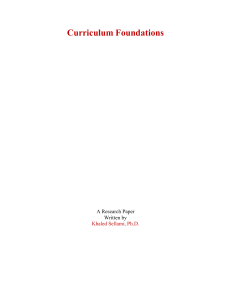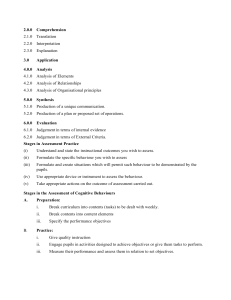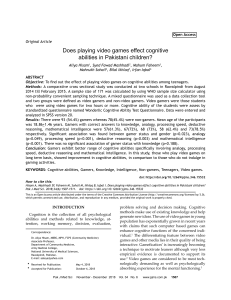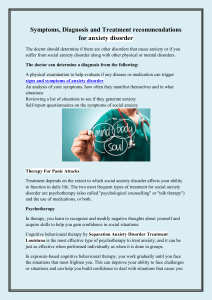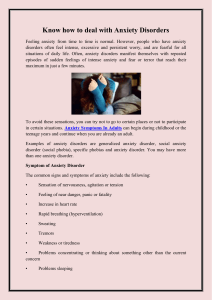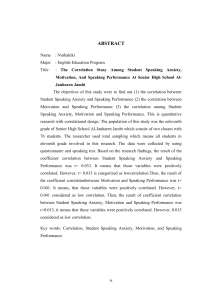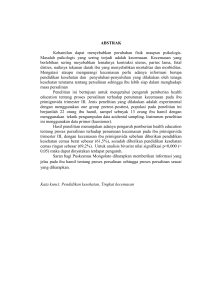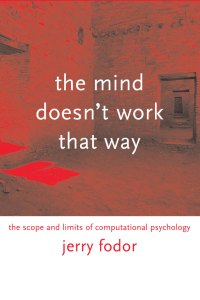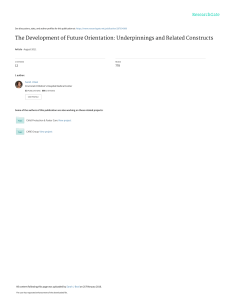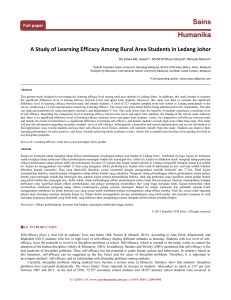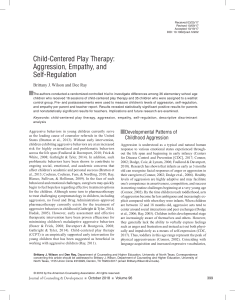Uploaded by
Tika Jolito
Motivational and Self-Regulated Learning in Classroom Performance
advertisement
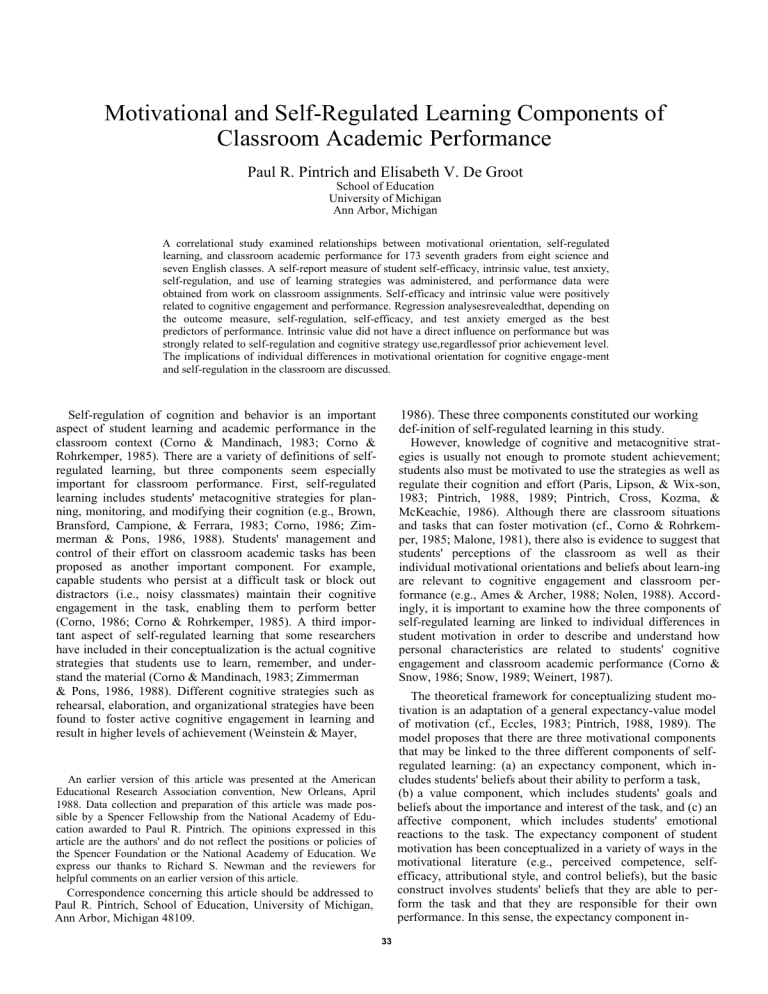
Motivational and Self-Regulated Learning Components of
Classroom Academic Performance
Paul R. Pintrich and Elisabeth V. De Groot
School of Education
University of Michigan
Ann Arbor, Michigan
A correlational study examined relationships between motivational orientation, self-regulated
learning, and classroom academic performance for 173 seventh graders from eight science and
seven English classes. A self-report measure of student self-efficacy, intrinsic value, test anxiety,
self-regulation, and use of learning strategies was administered, and performance data were
obtained from work on classroom assignments. Self-efficacy and intrinsic value were positively
related to cognitive engagement and performance. Regression analysesrevealedthat, depending on
the outcome measure, self-regulation, self-efficacy, and test anxiety emerged as the best
predictors of performance. Intrinsic value did not have a direct influence on performance but was
strongly related to self-regulation and cognitive strategy use,regardlessof prior achievement level.
The implications of individual differences in motivational orientation for cognitive engage-ment
and self-regulation in the classroom are discussed.
1986). These three components constituted our working
def-inition of self-regulated learning in this study.
However, knowledge of cognitive and metacognitive strategies is usually not enough to promote student achievement;
students also must be motivated to use the strategies as well as
regulate their cognition and effort (Paris, Lipson, & Wix-son,
1983; Pintrich, 1988, 1989; Pintrich, Cross, Kozma, &
McKeachie, 1986). Although there are classroom situations
and tasks that can foster motivation (cf., Corno & Rohrkemper, 1985; Malone, 1981), there also is evidence to suggest that
students' perceptions of the classroom as well as their
individual motivational orientations and beliefs about learn-ing
are relevant to cognitive engagement and classroom performance (e.g., Ames & Archer, 1988; Nolen, 1988). Accordingly, it is important to examine how the three components of
self-regulated learning are linked to individual differences in
student motivation in order to describe and understand how
personal characteristics are related to students' cognitive
engagement and classroom academic performance (Corno &
Snow, 1986; Snow, 1989; Weinert, 1987).
The theoretical framework for conceptualizing student motivation is an adaptation of a general expectancy-value model
of motivation (cf., Eccles, 1983; Pintrich, 1988, 1989). The
model proposes that there are three motivational components
that may be linked to the three different components of selfregulated learning: (a) an expectancy component, which includes students' beliefs about their ability to perform a task,
(b) a value component, which includes students' goals and
beliefs about the importance and interest of the task, and (c) an
affective component, which includes students' emotional
reactions to the task. The expectancy component of student
motivation has been conceptualized in a variety of ways in the
motivational literature (e.g., perceived competence, selfefficacy, attributional style, and control beliefs), but the basic
construct involves students' beliefs that they are able to perform the task and that they are responsible for their own
performance. In this sense, the expectancy component in-
Self-regulation of cognition and behavior is an important
aspect of student learning and academic performance in the
classroom context (Corno & Mandinach, 1983; Corno &
Rohrkemper, 1985). There are a variety of definitions of selfregulated learning, but three components seem especially
important for classroom performance. First, self-regulated
learning includes students' metacognitive strategies for planning, monitoring, and modifying their cognition (e.g., Brown,
Bransford, Campione, & Ferrara, 1983; Corno, 1986; Zimmerman & Pons, 1986, 1988). Students' management and
control of their effort on classroom academic tasks has been
proposed as another important component. For example,
capable students who persist at a difficult task or block out
distractors (i.e., noisy classmates) maintain their cognitive
engagement in the task, enabling them to perform better
(Corno, 1986; Corno & Rohrkemper, 1985). A third important aspect of self-regulated learning that some researchers
have included in their conceptualization is the actual cognitive
strategies that students use to learn, remember, and understand the material (Corno & Mandinach, 1983; Zimmerman
& Pons, 1986, 1988). Different cognitive strategies such as
rehearsal, elaboration, and organizational strategies have been
found to foster active cognitive engagement in learning and
result in higher levels of achievement (Weinstein & Mayer,
An earlier version of this article was presented at the American
Educational Research Association convention, New Orleans, April
1988. Data collection and preparation of this article was made possible by a Spencer Fellowship from the National Academy of Education awarded to Paul R. Pintrich. The opinions expressed in this
article are the authors' and do not reflect the positions or policies of
the Spencer Foundation or the National Academy of Education. We
express our thanks to Richard S. Newman and the reviewers for
helpful comments on an earlier version of this article.
Correspondence concerning this article should be addressed to
Paul R. Pintrich, School of Education, University of Michigan,
Ann Arbor, Michigan 48109.
33
34
PAUL R. PINTRICH AND ELISABETH V. DE GROOT
volves students' answers to the question, "Can I do this task?"
Different aspects of the expectancy component have been
linked to students' metacognition, their use of cognitive strategies, and their effort management. In general, the research
suggests that students who believe they are capable engage in
more metacognition, use more cognitive strategies, and are
more likely to persist at a task than students who do not
believe they can perform the task (e.g., Fincham & Cain,
1986; Paris & Oka, 1986; Schunk, 1985).
The value component of student motivation involves students' goals for the task and their beliefs about the importance
and interest of the task. Although this component has been
conceptualized in a variety of ways (e.g., learning vs. performance goals, intrinsic vs. extrinsic orientation, task value, and
intrinsic interest), this motivational component essentially
concerns students' reasons for doing a task. In other words,
what are students' individual answers to the question, "Why
am I doing this task?" The research suggests that students with
a motivational orientation involving goals of mastery,
learning, and challenge, as well as beliefs that the task is
interesting and important, will engage in more metacognitive
activity, more cognitive strategy use, and more effective effort
management (e.g., Ames & Archer, 1988; Dweck & Elliott,
1983; Eccles, 1983; Meece, Blumenfeld, & Hoyle, 1988; Nolen, 1988; Paris & Oka, 1986).
The third motivational component concerns students' affective or emotional reactions to the task. The important issue
for students involves the question, "How do I feel about this
task?" Again, there are a variety of affective reactions that
might be relevant (e.g., anger, pride, guilt), but in a school
learning context one of the most important seems to be test
anxiety (Wigfield & Eccles, 1989). Test anxiety has been
shown to be related to perceptions of competence (e.g., Nicholls, 1976), but it can be theoretically and empirically
distinct. Research on test anxiety has been linked to students'
metacognition, cognitive strategy use, and effort management
(e.g., Benjamin, McKeachie, Lin, & Holinger, 1981; Culler &
Holahan, 1980; Tobias, 1985). Although the other two motivational components generally show simple, positive, and
linear relations with the components of self-regulated learning, the results for test anxiety are not as straightforward. For
example, Benjamin et al. (1981) found that although highanxious students seemed to be as effortful and persistent as
low-anxious students, they appeared to be very ineffective and
inefficient learners who often did not use appropriate
cognitive strategies for achievement. On the other hand, other
research suggests that high-anxious children are not persistent
or avoid difficult tasks (Hill & Wigfield, 1984). Accordingly,
test anxiety may be related to the three components of selfregulated learning in different ways.
Previous research suggests that the expectancy and value
components will be positively related to the three self-regulated learning components, whereas the research on test anxiety does not suggest such simple relations. Accordingly, one
purpose of this study was to examine and clarify the empirical
relations between the motivational and self-regulated learning
components. In addition, because very few prior studies have
included all three motivational components in their designs, a
second purpose involved examining the potential interactive
relations of the three motivational components on self-regulated learning components. Finally, the relations between
motivation, self-regulated learning, and student performance
on classroom academic tasks were examined. The focus on
classroom assessments of student performance reflects a concern for ecologically valid indicators of the actual academic
work that students are asked to complete in junior high
classrooms (Doyle, 1983). Most students spend a great deal of
classroom time on seatwork assignments, quizzes, teachermade tests, lab problems, essays, and reports rather than on
standardized achievement tests (Stiggins & Bridgeford, 1985).
These assignments may not be the most psychometrically
sound assessments of student academic performance, but they
are closely related to the realities of instruction and learning in
most classrooms (Calfee, 1985). If we are to develop models
of student motivation and self-regulated learning that are
relevant for much of the academic work in classrooms, then it
is important to examine student performance on these types of
academic tasks (cf., Doyle, 1983; Pintrich et al., 1986).
Accordingly, the third purpose will provide empirical data on
how motivation and self-regulated learning components may
operate independently or jointly to influence student academic performance in the classroom. In summary, the three
research questions were:
1. How are the three motivational components related to
the components of self-regulated learning?
2. What are the interactions among the three
motivational components and their relation to the selfregulated learning components?
3. How are the motivational and self-regulated learning
components related to student performance on classroom
academic tasks?
Method
Subjects
The sample included 173 seventh-grade students from eight
science and seven English classrooms from a predominantly
White, middle-class, small city school district in southeastern
Michigan. There were 100 girls (57.8%) and 73 boys (42.2%).
The mean age of the students was 12 years, 6 months in January
at the end of the first semester. The school district did not track
students for the science or English classes at the two junior high
schools involved in this study. Accord-ingly, the sample of
students included a range of student achievement levels.
Measures
The students responded to a self-report questionnaire (the Motivated Strategies for Learning Questionnaire—MSLQ, see Appendix)
that included 56 items on student motivation, cognitive strategy use,
metacognitive strategy use, and management of effort. Students were
instructed to respond to the items on a 7-point Likert scale (1 = not at
all true of me to 7 = very true of me) in terms of their behavior in the
specific science or English class. Items were adapted from various
instruments used to assess student motivation, cognitive strategy use,
and metacognition (e.g., Eccles, 1983; Harter, 1981; Weinstein,
Schulte, & Palmer, 1987). Factor analysis was used to guide scale
construction, resulting in exclusion of some of the items from the
scales because of a lack of correlation or stable factor structure.
35
SPECIAL SECTION: MOTIVATION AND SELF-REGULATED LEARNING
Analysis of the motivational items revealed three distinct motivational factors: self-efficacy, intrinsic value, and test anxiety. The SelfEfficacy scale (a = .89) consisted of nine items regarding perceived
competence and confidence in performance of class work (e.g., "I
expect to do very well in this class," "I am sure that I can do an
excellent job on the problems and tasks assigned for this class," "I
know that I will be able to learn the material for this class"; cf. Eccles,
1983; Schunk, 1981). The Intrinsic Value scale (a = .87) was constructed by taking the mean score of the student's response to nine
items concerning intrinsic interest in ("I think what we are learning in
this Science class is interesting") and perceived importance of course
work ("It is important for me to learn what is being taught in this
English class"; cf., Eccles, 1983) as well as preference for challenge
and mastery goals ("I prefer class work that is challenging so I can
learn new things"; cf., Harter, 1981). Four items (e.g., "I am so nervous
during a test that I cannot remember facts I have learned," "When I
take a test I think about how poorly I am doing"; cf., Liebert
& Morris, 1967) concerning worry about and cognitive interference
on tests were used in the Test Anxiety scale (a — .75).
On the basis of the results of the factor analysis, two cognitive
scales were constructed: cognitive strategy use and self-regulation. The
Cognitive Strategy Use scale (a = .83) consisted of 13 items pertaining
to the use of rehearsal strategies (e.g., "When I read material for
science class, I say the words over and over to myself to help me
remember"), elaboration strategies such as summarizing and
paraphrasing (e.g., "When I study for this English class, I put important ideas into my own words"), and organizational strategies (e.g., "I
outline the chapters in my book to help me study", cf., Weinstein et al.,
1987). Although metacognitive and effort management strate-gies
were intended to be separate scales originally, factor analysis of the
items did not support the construction of two different scales. One
scale, labeled Self-Regulation (a = .74), was constructed from
metacognitive and effort management items. The items on metacognitive strategies, such as planning, skimming, and comprehension
monitoring (e.g., "I ask myself questions to make sure I know the
material I have been studying," "I find that when the teacher is talking
I think of other things and don't really listen to what is being said," and
"I often find that I have been reading for class but don't known what it
is all about," with the latter two items reflected before scale
construction) were adapted from Weinstein et al. (1987) and Zimmerman and Pons (1986). Effort management strategies were adapted
from Zimmerman and Pons (1986) and included students' persistence
at difficult or boring tasks and working diligently (e.g., "Even when
study materials are dull and uninteresting, I keep working until I
finish" and "When work is hard I either give up or study only the easy
parts," with the latter item reflected before scale construction).
Academic performance was measured by collecting data on student
performance on actual classroom tasks and assignments. Examination
of the classroom tasks and assignments for the different classrooms
revealed three general categories of tasks: (a) in-class seatwork and
homework, (b) quizzes and tests, and (c) essays and reports. In-class
seatwork and homework usually involved answering worksheets or
questions based on textbook readings. Exams and quizzes required
recall orrecognitionof information from textbooks as in the seatwork
assignments, although the students were not allowed to refer to their
textbooks on the quizzes and exams. Essays and reports involved the
production of original prose on topics assigned by the teacher or
chosen by the student. The essays and reports often required students
to use other sources (e.g., library books and encyclopedias) besides the
textbook to complete the assignment. Students' performance on these
three types ofgeneric assignments were averaged over the course of
the semester to generate one summary score for each of the three tasks.
The grading system in effect for all classrooms assigned points
(usually on a 100-point scale) or grades (on the traditional letter scale)
for correct and accurate performance on classroom tasks. All the
teachers involved used grading procedures that separated behavioral
compliance and effort from actual performance by providing separate
marks for attendance and class participation. These latter marks were
not included in the summary measures of classroom performance. The
distribution of grades for all classrooms followed an individual-istic,
criterion-referenced system that allowed all students the possi-bility
ofreceivingan A or a 100 on an assignment (i.e., none of the teachers
used an explicit "grading curve" to assign grades). Semester grades
also were obtained. We collected the first semester overall grade in the
course, administered the MSLQ, and then collected second semester
grades. All five performance scores (seatwork, tests/ quizzes,
essays/reports, and the two semester grades) were standard-ized
(converted to T scores) within each classroom before data analysis.
Results
The first question of the study concerned the relations between
the motivational and self-regulated learning compo-nents; the
results were generally as expected. Table 1 displays the zero-order
correlations and summary statistics for the motivational and selfregulated learning variables. As pre-dicted, higher levels of selfefficacy (r = .33) and intrinsic value (r = .63) were correlated with
higher levels of cognitive strategy use. Test anxiety was not
associated with cognitive strategy use. Paralleling these findings
for cognitive strategy use, higher levels of self-efficacy (r = .44)
and intrinsic value {r = .73) were correlated with higher levels of
self-regulation. Test anxiety was negatively correlated with selfregulation (r
= - . 13), albeit not at the .05 significance level. In addition,
simple polynomial regressions with second- and third-order terms
(Neter, Wasserman, & Kutner, 1985) for test anxiety revealed no
curvilinear relations between test anxiety and the cognitivestrategy-use or self-regulation variables.
The second research question concerned the potential interactions between the motivational variables on the two cognitive
scales. The two cognitive scales were correlated with each other
and were used as dependent variables in a multi-variate analysis
of covariance with prior achievement (first semester grade) as a
covariate (MANCOVA). In order to test for interactions, the three
motivational variables were dichoto-mized by median splits,
forming three low/high categorical variables to be used as
independent variables in the MANCOVA. Before the MANCOVA
was run, gender differences were exam-
Table 1
Summary Statistics and Zero-Order Correlations for
Motivation and Self-Regulated Learning Variables
Variable
1
1. Intrinsic value
2. Self-efficacy.48*
3. Test anxiety-.01-.34*
2
3
4
4. Strategy use
.63*
.33*
.04
5. Self-regulation
.73*
.44*
-.13
M
SD
Note. N= 173.
*p<.001.
5.44
0.89
5.47
1.00
3.58
1.67
5
.83*
5.20
0.77
5.03
0.83
36
PAUL R. PINTRICH AND ELISABETH V. DE GROOT
ined in preliminary analyses. Boys and girls did not differ on
any of the classroom performance variables or on the two
cognitive variables and intrinsic value. There were, however,
gender differences in self-efficacy; boys (M = 5.78) rated
themselves more efficacious than did girls (M= 5.23), r( 171)
= 3.53, p < .0005, and boys (M = 3.19) felt less test anxious
than did girls (M= 3.86), ?(171) = 2.67, p < .008. Preliminary
multivariate analyses of variance (MANOVAS) revealed no main
effects of gender on the two cognitive variables or interactive
effects with the three motivational variables. Consequently,
gender was excluded from the MANCOVA. TWO assumptions
for the MANCOVA were checked before the analysis proceeded.
The tests for homogeneity of regression coefficients of the
covariate for different levels of the motivational variables
were not significant, suggesting that a common regression
coefficient was appropriate for the covariance portion of the
analysis (Neter, Wasserman, & Kutner, 1985). In addition,
Box's M test for homogeneity of covariance matrices was not
significant; this provided assurance that a crucial assumption
of MANOVA was met (Stevens, 1986).
The results from the MANCOVA revealed a significant multivariate test for the covariate of prior achievement, Hotell-ing's
statistic = .05, S = 1, M = 0, N = 80 1/2, F(2, 163) = 3.97, p <
.02. The univariate tests showed that prior achieve-ment was a
significant predictor of self-regulation, r = .17, F(l, 164) = 4.80, p
< .03, MSe = 0.38, but not cognitive strategy use, r = .04, F(l,
164) = .27, p < .61, MS, = 0.43. Students who were achieving
high grades were more likely to report using self-regulatory
strategies than were low-achieving students, although there were
no differences in their cognitive strategy use. There were two
main effects of the motivational variables. The multivariate test
for self-efficacy was signifi-cant, Hotelling's statistic = .05, S = 1,
M = 0, N = 80 1/2, F(2, 163) = 4.07, p < .02. The univariate tests
were both significant also. Students high in self-efficacy were
more likely to report use of cognitive strategies, adjusted M =
5.41, F(\,
164) = 4.24, p < .04, MS, = 0.43, and self-regulatory strategies, adjusted M = 5.31, F(l, 164) = 8.16, p < .005, MSt =
0.38, than students low in self-efficacy (cognitive strategy
adjusted M = 4.97; self-regulation adjusted M = 4.74). The
other main effect involved intrinsic value with a significant
multivariate test, Hotelling's statistic = .42, S = 1, M = 0, N
= 80 1/2, F(2, 163) = 34.25, p < .0001. The two univariate
tests were also significant. Students high in intrinsic value
were more likely to use cognitive strategies, adjusted M =
5.58, F(l, 164) = 45.93, p < .0001, MS, = 0.43, and to be
self-regulating, adjusted M = 5.49, F{\, 164) = 68.40, p <
.0001, MS, = 0.38, than students low in intrinsic value
(cognitive strategy adjusted M= 4.80, self-regulation
adjusted M = 4.56). The main effect for test anxiety was
not significant at the multivariate or univariate level, nor
were any of the interaction terms for the motivational
variables significant at the multivariate or univariate level.
The third research question concerned how the motiva-tional
and cognitive variables were related to student perform-ance.
Table 2 displays the zero-order correlations for the
motivational, cognitive, and performance variables. As predicted, higher levels of intrinsic value and self-efficacy were
associated with higher levels of student achievement across all
types of tasks (see Table 2). Higher levels of test anxiety were
only significantly related to lower levels of performance on
exams and quizzes (/• = -.21) as well as grades at times one (r
= -.24) and two (r = -.23), but not for seatwork performance or
essays and lab reports. In addition, higher levels of cognitive
strategy use and self-regulation were asso-ciated with higher
levels of achievement on all assignments, with the exception of
seatwork performance and cognitive strategy use (see Table 2).
All the performance measures were significantly and positively
correlated with each other, sug-gesting that performance levels
were relatively stable over time. Because first and second
semester grades were highly correlated (/• = .77), one measure,
the average grade for the two semesters, was used in the
analyses. A MANOVA with the four performance measures as
dependent variables, following the logic of the previous
analysis for the two cognitive vari-ables, was ruled out because
the test (Box's M) for homoge-neity of covariance matrices was
significant. Accordingly, to examine the independent relations
between the motivational and cognitive variables on student
performance, four separate regression analyses were run with
the three motivational and two cognitive variables as predictors
of student performance on seatwork, exams/quizzes,
essays/reports, and average grade for the course.
Regression analysis of seatwork performance (r2 = .10)
revealed that self-regulation was positively related to seatwork
performance (partial r = . 18, p < .02). In addition, somewhat
surprisingly, cognitive strategy use was negatively related to
seatwork performance (partial r = -.18, p < .02). The three
Table 2
Zero-Order Correlations Between Motivation and Self-Regulated Learning
Variables and Performance
Grade
Variable
1
Motivation components
Intrinsic value
.25**
Self-efficacy
.34*..
Test anxiety
-.24**
Self-regulated learning components
Strategy use
.18*
Self-regulation
.32***
Note. /V= 173.
*p<.Q5. **p< . 01 . ***/?< .001.
Seatwork
Exams/
Quizzes
.21**
.19*
-.14
.20**
24*.
-.21**
.07
.22**
.20**
.28**
Essays/
Reports
Grade
.27**
.25**
-.14
.30***
.36***
-.23**
.19*
.36***
2
.20**
.36***
SPECIAL SECTION: MOTIVATION AND SELF-REGULATED LEARNING
motivational variables were not significantly related to seatwork performance when included in the regression analyses
with the two cognitive variables. For exams/quizzes (r2 =
.12), test anxiety was negatively related to performance (partial r = —.19, p < .02) and self-regulation was positively
related (partial r = .26, p < .0005). Cognitive strategy use, selfefficacy, and intrinsic value were not significant predictors of
exam performance in comparison with test anxiety and selfregulation. The results for essays/reports (r2 = .17) dis-played a
pattern similar to that revealed by the results for seatwork.
None of the motivational variables was significant, but selfregulation (partial r = .22, p < .0004) was positively related to
performance and cognitive strategy use negatively related
(partial r = -.17, p < .02). Regression analysis on average grade
(r2 = .22) revealed that the significant predictors were selfefficacy (partial r = . 18, p< .02) and self-regulation (partial r
= .22, p < .005). Analyses of variance (ANOVAS) with the
motivational and cognitive variables as independent dichotomous variables did not reveal any two- or three-way
interactions on the four student performance outcome
measures.
The findings that cognitive strategy use, which had a significant positive zero-order correlation with most of the performance measures (see Table 2), had negative partial correlations
and betas with performance when self-regulation was included
in the regression equation suggested a suppressor effect was
operating. Further examination of the partials, betas, and zeroorder correlations between cognitive strategy use, selfregulation, and the performance measures following the procedures to detect suppressor variables (e.g., Conger, 1974;
Tzelgov & Stern, 1978) suggested that cognitive strategy use
could be classified as a negative suppressor variable. Cognitive
strategy use and self-regulation were highly correlated with
each other (r = .83) and self-regulation was a better predictor
of performance. When the variance in performance due to selfregulation was accounted for, the remaining variance
correlated with cognitive strategy use revealed a negative
relation. This suggested that some students who reported that
they often used cognitive strategies also reported infrequent
use of self-regulatory strategies. Examination of the actual
number of students who showed this pattern revealed that 14
students (8% of the sample) could be classified as being in the
top third on cognitive strategy use and the bottom third in selfregulation. Simple two-way ANOVAS did not reveal a significant interaction between cognitive strategy use (three levels) and self-regulation (three levels), but the group low in selfregulation and high in cognitive strategy use consistently had
means on the performance measures well below the 50.0 mean
for the total sample (seatwork M = 45.6, exam M = 47.3, essay
M = 42.0, average grade M = 43.2) or the other group means,
which were all above 46.2.
Discussion
The results provide an empirical base for the specification and
elaboration of the theoretical linkages between individual
differences in students' motivational orientation and their
cognitive engagement and self-regulation in classroom settings
37
(cf., Corno & Mandinach, 1983; Snow, 1989; Weinert, 1987).
The motivational components were linked in important ways to
student cognitive engagement and academic performance in the
classroom. Self-efficacy was positively related to student
cognitive engagement and performance. Students who be-lieved
they were capable were more likely to report use of cognitive
strategies, to be more self-regulating in terms of reporting more
use of metacognitive strategies, and to persist more often at
difficult or uninteresting academic tasks. These relations were
independent of and did not interact with prior achievement levels
or intrinsic value and test anxiety. Self-efficacy, however, was not
significantly related to performance on seatwork, exams, or
essays when the cognitive engagement variables were included in
the regression analyses. These findings suggest that self-efficacy
plays a facilitative role in relation to cognitive engagement as
suggested by Schunk (1985), but that the cognitive engagement
variables are more directly tied to actual performance. This
implies that teaching students about different cognitive and selfregulatory strate-gies may be more important for improving actual
perform-ance on classroom academic tasks, but that improving
stu-dents' self-efficacy beliefs may lead to more use of these
cognitive strategies (cf., Borkowski, Weyhing, & Carr, 1988;
Garner & Alexander, 1989; Schunk, 1985).
Intrinsic value was very strongly related to use of cognitive
strategies and self-regulation, independent of initial performance levels or self-efficacy and test anxiety. Students who
were motivated to learn the material (not just get good grades)
and believed that their school work was interesting and
important were more cognitively engaged in trying to learn and
compre-hend the material. In addition, these students were
more likely to be self-regulating and to report that they
persisted on their academic work. It is important to note that
intrinsic value did not have a significant direct relation to
student performance in any of the regressions that included
cognitive strategy use or self-regulation. The cognitive
variables, self-regulation in particular, were better predictors of
actual aca-demic performance. This finding parallels the work
of Eccles (1983), who found that value components did not
have a direct influence on student achievement in math but
were closely tied to students' choice of future math courses. In
a similar fashion, our data suggest that intrinsic value is an
important component of students' "choice" about becoming
cognitively engaged in their classroom academic work. Although our correlational data cannot address causality, it
appears that the students who choose to become cognitively
engaged and self-regulating are those who are interested in and
value the tasks they work on in their classrooms. Accord-ingly,
students' intrinsic value and motivation to learn is an important
component to be considered in our models of how students
come to use different cognitive strategies and become selfregulating learners (cf., Meece et al., 1988; Nolen, 1988). In
addition, the results imply that it is important for teachers to
socialize students' intrinsic value for schoolwork (cf., Bro-phy,
1983; Corno & Rohrkemper, 1985), not because it will
necessarily lead to higher grades or scores on academic assignments or standardized achievement tests directly, but because
it may lead to more cognitive engagement in the day-to-day
work of the classroom.
38
PAUL R. PINTRICH AND ELISABETH V. DE GROOT
Test anxiety was not significantly related in a linear or
nonlinear fashion to use of cognitive strategies or self-regulation, but it was negatively related to self-efficacy and performance on exams and quizzes. The linear relation between test
anxiety and self-regulation, although not significant, was in
the expected direction; high-anxious students reported less
self-regulation and persistence (cf., Hill & Wigfield, 1984).
The direct relation between test anxiety and exam performance and the lack of any interactions between test anxiety and
self-regulation suggest that, for this sample of students, the
effects of test anxiety are related to retrieval problems at the
time of testing rather than to lack of effective cognitive
strategies for encoding or organizing course material. This
interpretation is in line with cognitive models of test anxiety
(e.g., Benjamin, McKeachie, & Lin, 1987; Tobias, 1985) that
propose that for some test-anxious students who actually have
adequate cognitive skills, test anxiety during exams engenders
worry about their capabilities that interferes with effective
performance. This interpretation is further supported by the
negative relation between self-efficacy and test anxiety in this
sample.
Thefindingsfor the cognitive variables provide ecologically
valid data on academic performance on actual classroom tasks
in support of a general model of self-regulated learning.
Students who were more cognitively engaged in trying to learn
by memorizing, organizing, and transforming classroom material through the use of rehearsal, elaboration, and organizational cognitive strategies performed better than students who
tended not to use these strategies (Corno and Mandinach, 1983;
Weinstein & Mayer, 1986). More important, the finding that
self-regulation was the best predictor of academic per-formance
on all the outcome measures suggests that the use of selfregulating strategies, such as comprehension monitor-ing, goal
setting, planning, and effort management and per-sistence, is
essential for academic performance on different types of actual
classroom tasks (Corno, 1986; Zimmerman & Pons, 1986,
1988). Self-regulation was highly correlated with cognitive
strategy use, yet the two constructs can be distin-guished
conceptually, and when both were entered as predic-tors of
academic performance, cognitive strategy use had a negative
relation to performance. This apparent negative sup-pressor
effect of cognitive strategy use on academic perform-ance
suggests that cognitive strategy use without the concom-mitant
use of self-regulatory strategies is not conducive to academic
performance. This interpretation is in line with the research on
metacognition and self-regulation that suggests that students
must be able to understand not only the "what" of cognitive
strategies, but also how and when to use strategies
appropriately (cf., Brown et al., 1983; Paris et al., 1983;
Pressley, 1986).
There are several limitations to these findings, however.
First, all the student motivation and cognitive components
were measured with a self-report instrument. Self-reports can
be used effectively to measure student perceptions of motivation and cognitive engagement (e.g., Ames & Archer, 1988;
Meece et al., 1988; Weinstein et al., 1987), but the results
need to be replicated with other measures, such as think-aloud
protocols, stimulated recall procedures, structured in-terviews,
or behavioral measures (cf., Garner & Alexander,
1989; Zimmerman & Pons, 1986). The negative suppressor
effect of cognitive strategy use may merely reflect methodological problems involved in using a self-report instrument for
assessing cognitive strategy use with junior high school
students. In addition, it seems clear from the moderate levels
of variance explained on the performance measures that there
are other factors implicated in student academic performance
in the classroom. For example, seatwork performance may
reflect both students' willingness to comply with classroom
norms about work completion and teachers' grading practices
with respect to student behavioral compliance (e.g., Blumenfeld, Pintrich, & Hamilton, 1987; Hamilton, Blumenfeld, &
Kunstler, 1987). Student knowledge factors, including the
amount and organization of prior knowledge, were not assessed, yet they relate to student academic performance and
potentially interact with cognitive and metacognitive strategy
use (Alexander & Judy, 1988). Finally, these relationships
may vary by classroom task and context variables. Different
relationships between student motivational and self-regulated
learning components and academic performance may be
obtained with younger or older students or in different classroom settings (e.g., cooperative-competitive or ability
grouped-ungrouped) that have different arrays of classroom
tasks (e.g., Ames & Archer, 1988; Doyle, 1983). Clearly, more
ecologically valid classroom research is needed on the multivariate relationships between student academic performance
and student motivational orientation and self-regulated learning as well as social cognitive and knowledge factors in
different classroom contexts.
In summary, the results provide ecologically valid empirical
evidence for the importance of considering both motivational
and self-regulated learning components in our models of
classroom academic performance. Student involvement in
self-regulated learning is closely tied to students' efficacy
beliefs about their capability to perform classroom tasks and
to their beliefs that these classroom tasks are interesting and
worth learning. At the same time, these motivational beliefs
are not sufficient for successful academic performance; selfregulated learning components seem to be more directly
implicated in performance. Students need to have both the
"will" and the "skill" to be successful in classrooms (cf.,
Blumenfeld, Pintrich, Meece, & Wessels, 1982; Paris et al.,
1983; Pintrich, 1989), and we need to integrate these components in our models of classroom learning.
References
Alexander, P., & Judy, J. (1988). The interaction of domainspecific and strategic knowledge in academic performance.
Review of Ed-ucational Research, 58, 375-404.
Ames, C, & Archer, J. (1988). Achievement goals in the
classroom: Student learning strategies and motivation
processes. Journal of Educational Psychology, 80, 260-267.
Benjamin, M., McKeachie, W. J., Lin, Y. G., & Holinger, D. P.
(1981). Test anxiety: Deficits in information processing.
Journal of Educational Psychology, 73, 816-824.
Benjamin, M., McKeachie, W. J., & Lin, Y. G. (1987). Two types of
test-anxious students: Support for an information processing
model. Journal of Educational Psychology, 79, 131-136.
Blumenfeld, P. C, Pintrich, P. R., & Hamilton, V. L. (1987). Teacher
SPECIAL SECTION: MOTIVATION AND SELF-REGULATED LEARNING
talk and students' reasoning about morals, conventions, and
achievement. Child Development, 58, 1389-1401.
Blumenfeld, P. C, Pintrich, P. R., Meece, J., & Wessels, K. (1982).
The role and formation of self-perceptions of ability in elementary
classrooms. Elementary School Journal, 82, 401-420.
Borkowski, J., Weyhing, R., & Carr, M. (1988). Effects of attributional
retraining on strategy-based reading comprehension in learning-disabled
students. Journal of Educational Psychology, 80, 46-53.
Brophy, J. (1983). Conceptualizing student motivation.
Educational Psychologist, 18, 200-215.
Brown, A. L., Bransford, J. D., Campione, J. C, & Ferrara, R. A.
(1983). Learning, remembering and understanding. In J. Flavell &
E. Markman (Eds.), Handbook of child psychology: Vol. 3. Cognitive Development (pp. 77-166). New York: Wiley.
Calfee, R. (1985). Home grown tests have virtues, too. Update:
The study ofStanford and the schools, 2, 3.
Conger, A. J. (1974). A revised definition for suppressor
variables: A guide to their identification and interpretation.
Educational and Psychological Measurement, 34, 35-46.
Corno, L. (1986). The metacognitive control components of selfregulated learning. Contemporary Educational Psychology, 11,
333-346.
Corno, L., & Mandinach, E. (1983). The role of cognitive
engagement in classroom learning and motivation. Educational
Psychologist, 18, 88-100.
Corno, L., & Rohrkemper, M. (1985). The intrinsic motivation to
learn in classrooms. In C. Ames & R. Ames (Eds.), Research on
motivation: Vol. 2. The classroom milieu (pp. 53-90). New York:
Academic Press.
Corno, L., & Snow, R. (1986). Adapting teaching to individual
differences among learners. In M. Wittrock (Ed.), Handbook of
research on teaching (pp. 605-629). New York: Macmillan.
Culler, R. E., & Holahan, C. J. (1980). Test anxiety and academic
performance: The effects of study related behaviors. Journal of
Educational Psychology, 72, 16-20.
Doyle, W. (1983). Academic work. Review of Educational
Research, 53, 159-200.
Dweck, C, & Elliott, E. (1983). Achievement motivation. In E. M.
Heatherington (Ed.), Handbook ofchild psychology: Vol. 4.
Social-ization, personality, and social development, (pp. 643691). New York: Wiley.
Eccles, J. (1983). Expectancies, values and academic behaviors. In J.
T. Spence (Ed.), Achievement and achievement motives (pp.
75-146). San Francisco: Freeman.
Fincham, F., & Cain, K. (1986). Learned helplessness in humans:
A developmental analysis. Developmental Review, 6, 25-86.
Garner, R., & Alexander, P. (1989). Metacognition: Answered and
unanswered questions. Educational Psychologist, 24, 143-158.
Hamilton, V. L., Blumenfeld, P. C, & Kunstler, R. H. (1988). A
question of standards: Attributions of blame and credit for classroom acts. Journal of Personality and Social Psychology, 54, 3448.
Harter, S. (1981). A new self-report scale of intrinsic versus extrinsic
orientation in the classroom: Motivational and informational components. Developmental Psychology, 17, 300-312.
Hill, K., & Wigfield, A. (1984). Test anxiety: A major educational
problem and what can be done about it. Elementary School
Jour-nal, 85, 105-126.
Liebert, R., & Morris, L. (1967). Cognitive and emotional components of test anxiety: A distinction and some initial data.
Psycho-logical Reports, 29, 975-978.
Malone, T. W. (1981). Toward a theory of intrinsically
motivating instruction. Cognitive Science, 4, 333-369.
39
Meece, J., Blumenfeld, P., & Hoyle, R. (1988). Students' goal
orien-tations and cognitive engagement in classroom activities.
Journal ofEducational Psychology, 80, 514-523.
Neter, J., Wasserman, W., & Kutner, M. (1985). Applied linear
statistical models. Homewood, IL: Richard D. Irwin.
Nicholls, J. (1976). When a scale measures more than its name
denotes: The case of the Test Anxiety Scale for Children.
Journal of Consulting and Clinical Psychology, 44, 976-985.
Nolen, S. (1988). Reasons for studying: Motivational orientations
and study strategies. Cognition and Instruction, 5, 269-287.
Paris, S. G., Lipson, M. Y., & Wixson, K. (1983). Becoming a strategic
reader. Contemporary Educational Psychology, 8, 293-316.
Paris, S. G., & Oka, E. (1986). Children's reading strategies, metacognition and motivation. Developmental Review, 6, 25-86.
Pintrich, P. R. (1988). A process-oriented view of student motivation
and cognition. In J. S. Stark & L. Mets (Eds.), Improving teaching
and learning through research. New directions for institutional
research, 57 (pp. 55-70). San Francisco: Jossey-Bass.
Pintrich, P. R. (1989). The dynamic interplay of student motivation and
cognition in the college classroom. In C. Ames & M. Maehr (Eds.),
Advances in motivation and achievement: Vol. 6. Motivation enhancing
environments (pp. 117-160). Greenwich, CT: JAI Press.
Pintrich, P. R., Cross, D. R., Kozma, R. B., & McKeachie, W. J.
(1986). Instructional psychology. Annual Review ofPsychology,
37, 611-651.
Pressley, M. (1986). The relevance of the good strategy user model
to the teaching of mathematics. Educational Psychologist, 21,
139-161.
Schunk, D. (1981). Modeling and attributional effects on
children's achievement: A self-efficacy analysis. Journal of
Educational Psy-chology, 73, 93-105.
Schunk, D. (1985). Self-efficacy and school learning. Psychology
in the Schools, 22, 208-223.
Snow, R. (1989). Aptitude-treatment interaction as a framework
for research on individual differences in learning. In P.
Ackerman, R. Sternberg, & R. Glaser (Eds.), Learning and
individual differences (pp. 13-59). New York: Freeman.
Stevens, J. (1986). Applied multivariate statistics for the social sciences. Hillsdale, NJ: Erlbaum.
Stiggins, R., & Bridgeford, N. (1985). The ecology of classroom
assessment. Journal ofEducational Measurement, 22, 271-286.
Tobias, S. (1985). Test anxiety: Interference, defective skills, and
cognitive capacity. Educational Psychologist, 20, 135-142.
Tzelgov, J., & Stern, I. (1978). Relationships between variables in
three variable linear regression and the concept of suppressor.
Educational and Psychological Measurement, 38, 325-335.
Weinert, F. (1987). Metacognition and motivation as determinants
of effective learning and understanding. In F. Weinert & R.
Kluwe (Eds.), Metacognition, motivation, and understanding
(pp. 1-15). Hillsdale, NJ: Erlbaum.
Weinstein, C. E., & Mayer, R. E. (1986). The teaching of learning
strategies. In M. Wittrock (Ed.), Handbook of research on
teaching (pp. 315-327). New York: Macmillan.
Weinstein, C. E., Schulte, A., & Palmer, D. R. (1987). The Learning
and Study Strategies Inventory. Clearwater, FL: H & H Publishing.
Wigfield, A., & Eccles, J. (1989). Test anxiety in elementary and
secondary school students. Educational Psychologist, 24, 159-183.
Zimmerman, B., & Pons, M. (1986). Development of a structured
interview for assessing student use of self-regulated learning strategies. American Educational Research Journal, 23, 614-628.
Zimmerman, B., & Pons, M. (1988). Construct validation ofa
strategy model of student self-regulated learning. Journal of
Educational Psychology, 80, 284-290.
(Appendixfollows on next page)
40
PAUL R. PINTRICH AND ELISABETH V. DE GROOT
Appendix
The following scales and items represent the Motivated Strategies
for Learning Questionnaire (MSLQ) that was used in this study to
measure students' motivational beliefs and self-regulated learning.
The numbers next to the items reflect the item's actual position on the
questionnaire. Items marked (*R) were reflected before scale
construction. There were 56 items on the questionnaire, but only 44
were used in this study to form the following five scales.
Motivational Beliefs
A. Self-Efficacy
2. Compared with other students in this class I expect to do
well.
7. I'm certain I can understand the ideas taught in this course.
10. I expect to do very well in this class.
11. Compared with others in this class, I think I'm a good student.
13. I am sure I can do an excellent job on the problems and
tasks assigned for this class.
15.1 think I will receive a good grade in this class.
20. My study skills are excellent compared with others in this
class.
22. Compared with other students in this class I think I know
a great deal about the subject.
23. I know that I will be able to learn the material for this class.
B. Intrinsic Value
1. I prefer class work that is challenging so I can learn new
things.
5. It is important for me to learn what is being taught in this
class.
6. I like what I am learning in this class.
9. I think I will be able to use what I learn in this class in
other classes.
12. I often choose paper topics I will learn something from
even if they require more work.
17. Even when I do poorly on a test I try to learn from my
mistakes.
18. I think that what I am learning in this class is useful for
me to know.
21. I think that what we are learning in this class is interesting.
25. Understanding this subject is important to me.
C. Test Anxiety
3. I am so nervous during a test that I cannot remember facts
I have learned.
14. I have an uneasy, upset feeling when I take a test.
24. I worry a great deal about tests.
27. When I take a test I think about how poorly I am doing.
Self-Regulated Learning Strategies
D. Cognitive Strategy Use
30. When I study for a test, I try to put together the
information from class and from the book.
31. When I do homework, I try to remember what the teacher
said in class so I can answer the questions correctly.
33. It is hard for me to decide what the main ideas are in
what I read. (*R)
35. When I study I put important ideas into my own words.
36. I always try to understand what the teacher is saying even
if it doesn't make sense.
38. When I study for a test I try to remember as many facts as
I can.
39. When studying, I copy my notes over to help me
remember material.
42. When I study for a test I practice saying the important
facts over and over to myself.
44. I use what I have learned from old homework
assignments and the textbook to do new assignments.
47. When I am studying a topic, I try to make everything fit
together.
53. When I read material for this class, I say the words over
and over to myself to help me remember.
54. I outline the chapters in my book to help me study.
56. When reading I try to connect the things I am reading
about with what I already know.
E. Self-Regulation
32. I ask myself questions to make sure I know the material I
have been studying.
34. When work is hard I either give up or study only the easy
parts. (*R)
40. I work on practice exercises and answer end of chapter
questions even when I don't have to.
41. Even when study materials are dull and uninteresting, I
keep working until I finish.
43. Before I begin studying I think about the things I will
need to do to learn.
45. I often find that I have been reading for class but don't
know what it is all about. (*R)
46. I find that when the teacher is talking I think of other
things and don't really listen to what is being said. (*R)
52. When I'm reading I stop once in a while and go over what
I have read.
55. 1 work hard to get a good grade even when I don't like a class.
Received July 13, 1988
Revision received July 7, 1989
Accepted September 12, 1989 •
